BMP3002 Semester 1: Analysis of Different Types of Companies
VerifiedAdded on 2023/01/03
|13
|2727
|40
Report
AI Summary
This report provides a comprehensive analysis of various company types, starting with an introduction to the business concept and the specific case of Tesco PLC. The first section differentiates between micro, small, medium, and large businesses, outlining their definitions, characteristics, and examples. The second section delves into different legal structures, comparing sole traders, partnerships, limited liability businesses, public liability businesses, and cooperatives. Furthermore, the report includes an external analysis of Tesco PLC using the PESTLE framework, examining political, economic, social, technological, legal, and environmental factors. An internal analysis, employing VRIO and SWOT analyses, evaluates Tesco's resources, capabilities, strengths, weaknesses, opportunities, and threats. The conclusion summarizes the key findings and insights derived from the analysis. References are provided to support the information presented.

Paraphrase This Document
Need a fresh take? Get an instant paraphrase of this document with our AI Paraphraser
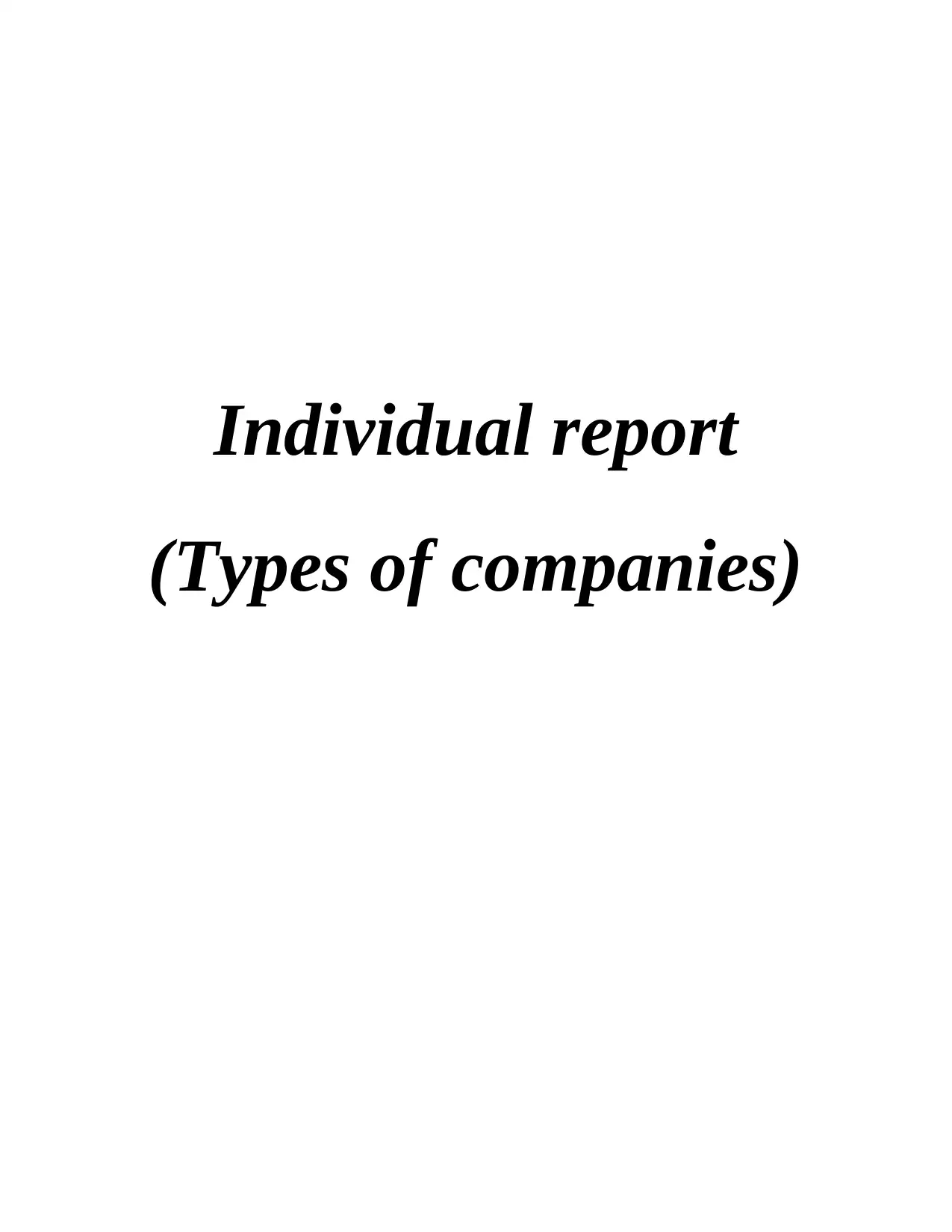
Individual report
(Types of companies)
(Types of companies)
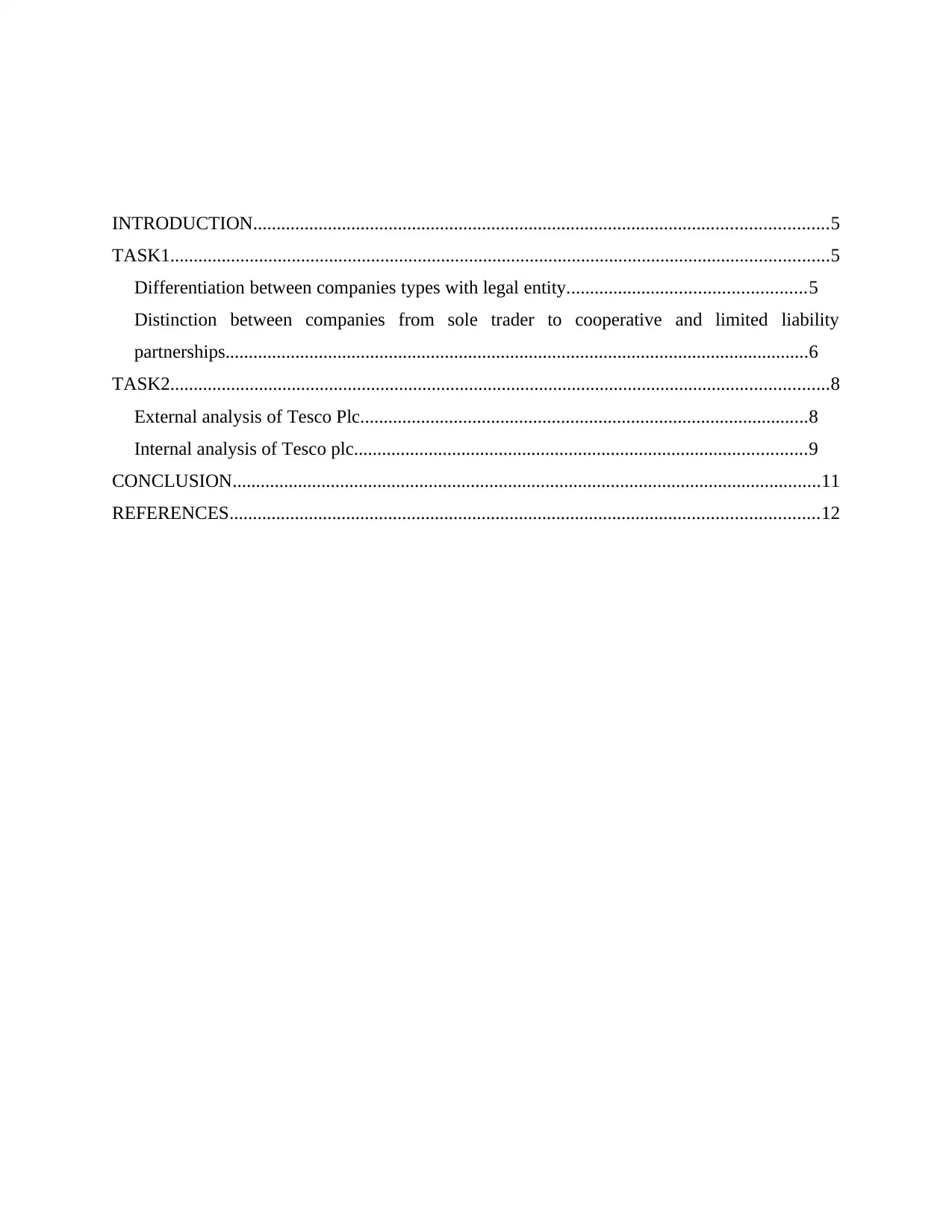
INTRODUCTION...........................................................................................................................5
TASK1.............................................................................................................................................5
Differentiation between companies types with legal entity...................................................5
Distinction between companies from sole trader to cooperative and limited liability
partnerships.............................................................................................................................6
TASK2.............................................................................................................................................8
External analysis of Tesco Plc................................................................................................8
Internal analysis of Tesco plc.................................................................................................9
CONCLUSION..............................................................................................................................11
REFERENCES..............................................................................................................................12
TASK1.............................................................................................................................................5
Differentiation between companies types with legal entity...................................................5
Distinction between companies from sole trader to cooperative and limited liability
partnerships.............................................................................................................................6
TASK2.............................................................................................................................................8
External analysis of Tesco Plc................................................................................................8
Internal analysis of Tesco plc.................................................................................................9
CONCLUSION..............................................................................................................................11
REFERENCES..............................................................................................................................12
⊘ This is a preview!⊘
Do you want full access?
Subscribe today to unlock all pages.

Trusted by 1+ million students worldwide

4
Paraphrase This Document
Need a fresh take? Get an instant paraphrase of this document with our AI Paraphraser
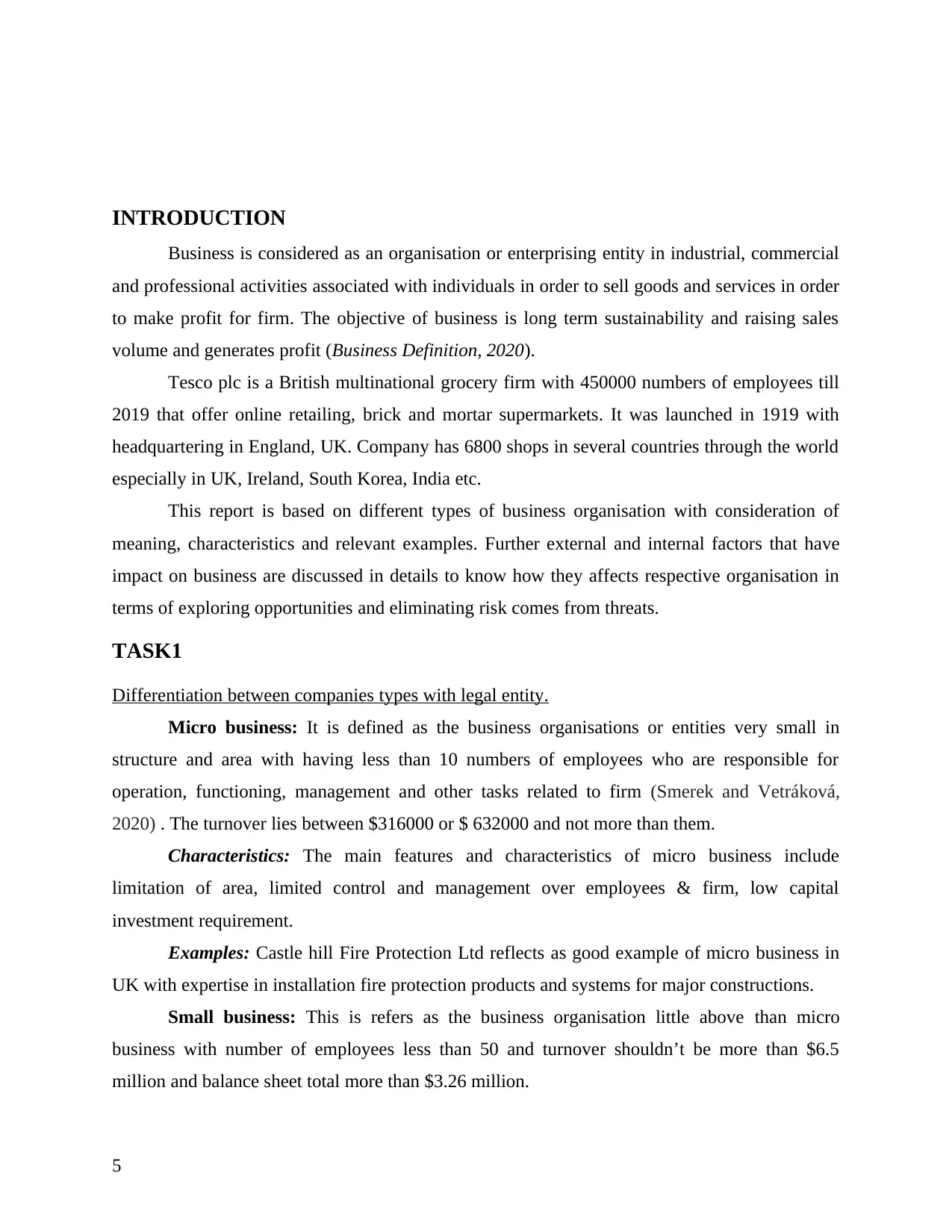
INTRODUCTION
Business is considered as an organisation or enterprising entity in industrial, commercial
and professional activities associated with individuals in order to sell goods and services in order
to make profit for firm. The objective of business is long term sustainability and raising sales
volume and generates profit (Business Definition, 2020).
Tesco plc is a British multinational grocery firm with 450000 numbers of employees till
2019 that offer online retailing, brick and mortar supermarkets. It was launched in 1919 with
headquartering in England, UK. Company has 6800 shops in several countries through the world
especially in UK, Ireland, South Korea, India etc.
This report is based on different types of business organisation with consideration of
meaning, characteristics and relevant examples. Further external and internal factors that have
impact on business are discussed in details to know how they affects respective organisation in
terms of exploring opportunities and eliminating risk comes from threats.
TASK1
Differentiation between companies types with legal entity.
Micro business: It is defined as the business organisations or entities very small in
structure and area with having less than 10 numbers of employees who are responsible for
operation, functioning, management and other tasks related to firm (Smerek and Vetráková,
2020) . The turnover lies between $316000 or $ 632000 and not more than them.
Characteristics: The main features and characteristics of micro business include
limitation of area, limited control and management over employees & firm, low capital
investment requirement.
Examples: Castle hill Fire Protection Ltd reflects as good example of micro business in
UK with expertise in installation fire protection products and systems for major constructions.
Small business: This is refers as the business organisation little above than micro
business with number of employees less than 50 and turnover shouldn’t be more than $6.5
million and balance sheet total more than $3.26 million.
5
Business is considered as an organisation or enterprising entity in industrial, commercial
and professional activities associated with individuals in order to sell goods and services in order
to make profit for firm. The objective of business is long term sustainability and raising sales
volume and generates profit (Business Definition, 2020).
Tesco plc is a British multinational grocery firm with 450000 numbers of employees till
2019 that offer online retailing, brick and mortar supermarkets. It was launched in 1919 with
headquartering in England, UK. Company has 6800 shops in several countries through the world
especially in UK, Ireland, South Korea, India etc.
This report is based on different types of business organisation with consideration of
meaning, characteristics and relevant examples. Further external and internal factors that have
impact on business are discussed in details to know how they affects respective organisation in
terms of exploring opportunities and eliminating risk comes from threats.
TASK1
Differentiation between companies types with legal entity.
Micro business: It is defined as the business organisations or entities very small in
structure and area with having less than 10 numbers of employees who are responsible for
operation, functioning, management and other tasks related to firm (Smerek and Vetráková,
2020) . The turnover lies between $316000 or $ 632000 and not more than them.
Characteristics: The main features and characteristics of micro business include
limitation of area, limited control and management over employees & firm, low capital
investment requirement.
Examples: Castle hill Fire Protection Ltd reflects as good example of micro business in
UK with expertise in installation fire protection products and systems for major constructions.
Small business: This is refers as the business organisation little above than micro
business with number of employees less than 50 and turnover shouldn’t be more than $6.5
million and balance sheet total more than $3.26 million.
5
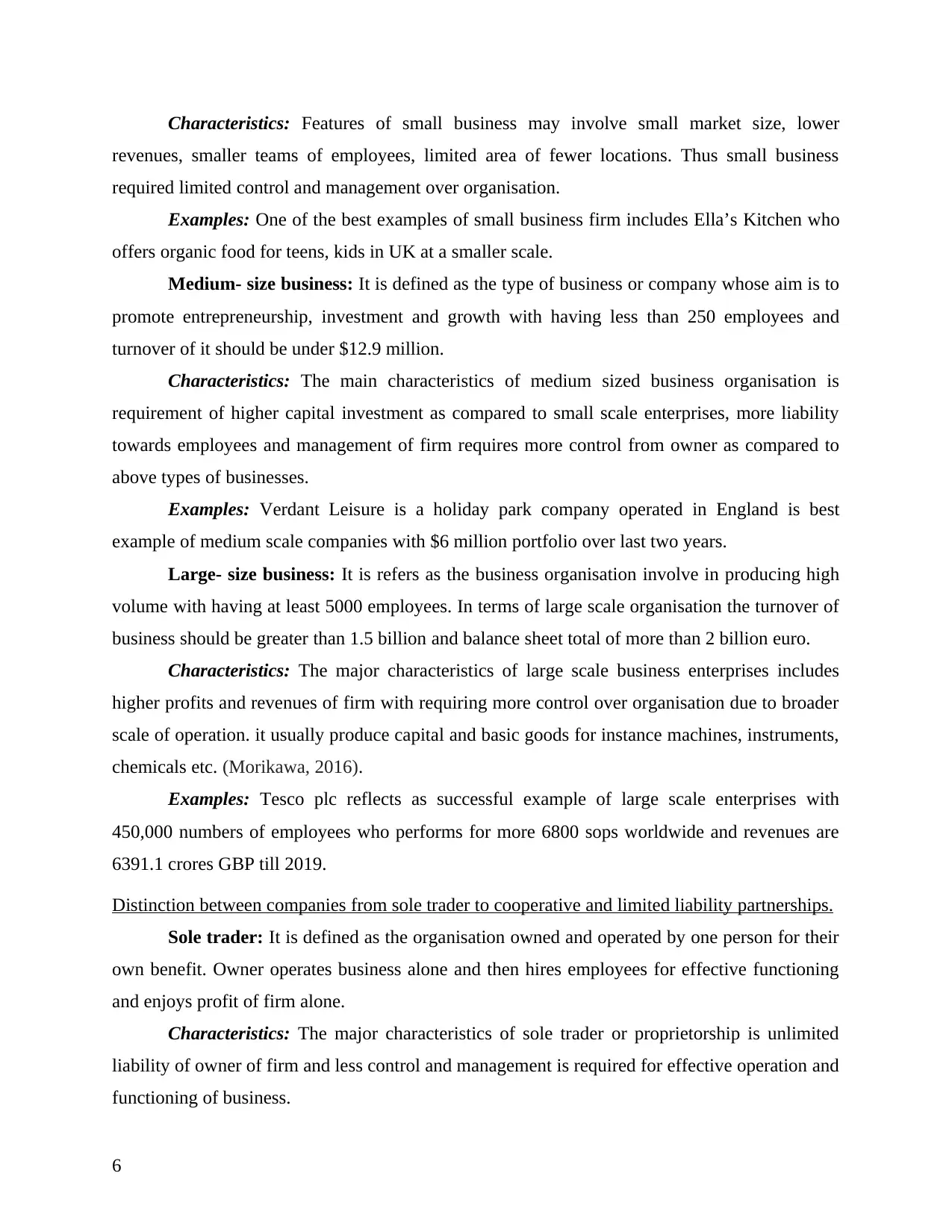
Characteristics: Features of small business may involve small market size, lower
revenues, smaller teams of employees, limited area of fewer locations. Thus small business
required limited control and management over organisation.
Examples: One of the best examples of small business firm includes Ella’s Kitchen who
offers organic food for teens, kids in UK at a smaller scale.
Medium- size business: It is defined as the type of business or company whose aim is to
promote entrepreneurship, investment and growth with having less than 250 employees and
turnover of it should be under $12.9 million.
Characteristics: The main characteristics of medium sized business organisation is
requirement of higher capital investment as compared to small scale enterprises, more liability
towards employees and management of firm requires more control from owner as compared to
above types of businesses.
Examples: Verdant Leisure is a holiday park company operated in England is best
example of medium scale companies with $6 million portfolio over last two years.
Large- size business: It is refers as the business organisation involve in producing high
volume with having at least 5000 employees. In terms of large scale organisation the turnover of
business should be greater than 1.5 billion and balance sheet total of more than 2 billion euro.
Characteristics: The major characteristics of large scale business enterprises includes
higher profits and revenues of firm with requiring more control over organisation due to broader
scale of operation. it usually produce capital and basic goods for instance machines, instruments,
chemicals etc. (Morikawa, 2016).
Examples: Tesco plc reflects as successful example of large scale enterprises with
450,000 numbers of employees who performs for more 6800 sops worldwide and revenues are
6391.1 crores GBP till 2019.
Distinction between companies from sole trader to cooperative and limited liability partnerships.
Sole trader: It is defined as the organisation owned and operated by one person for their
own benefit. Owner operates business alone and then hires employees for effective functioning
and enjoys profit of firm alone.
Characteristics: The major characteristics of sole trader or proprietorship is unlimited
liability of owner of firm and less control and management is required for effective operation and
functioning of business.
6
revenues, smaller teams of employees, limited area of fewer locations. Thus small business
required limited control and management over organisation.
Examples: One of the best examples of small business firm includes Ella’s Kitchen who
offers organic food for teens, kids in UK at a smaller scale.
Medium- size business: It is defined as the type of business or company whose aim is to
promote entrepreneurship, investment and growth with having less than 250 employees and
turnover of it should be under $12.9 million.
Characteristics: The main characteristics of medium sized business organisation is
requirement of higher capital investment as compared to small scale enterprises, more liability
towards employees and management of firm requires more control from owner as compared to
above types of businesses.
Examples: Verdant Leisure is a holiday park company operated in England is best
example of medium scale companies with $6 million portfolio over last two years.
Large- size business: It is refers as the business organisation involve in producing high
volume with having at least 5000 employees. In terms of large scale organisation the turnover of
business should be greater than 1.5 billion and balance sheet total of more than 2 billion euro.
Characteristics: The major characteristics of large scale business enterprises includes
higher profits and revenues of firm with requiring more control over organisation due to broader
scale of operation. it usually produce capital and basic goods for instance machines, instruments,
chemicals etc. (Morikawa, 2016).
Examples: Tesco plc reflects as successful example of large scale enterprises with
450,000 numbers of employees who performs for more 6800 sops worldwide and revenues are
6391.1 crores GBP till 2019.
Distinction between companies from sole trader to cooperative and limited liability partnerships.
Sole trader: It is defined as the organisation owned and operated by one person for their
own benefit. Owner operates business alone and then hires employees for effective functioning
and enjoys profit of firm alone.
Characteristics: The major characteristics of sole trader or proprietorship is unlimited
liability of owner of firm and less control and management is required for effective operation and
functioning of business.
6
⊘ This is a preview!⊘
Do you want full access?
Subscribe today to unlock all pages.

Trusted by 1+ million students worldwide
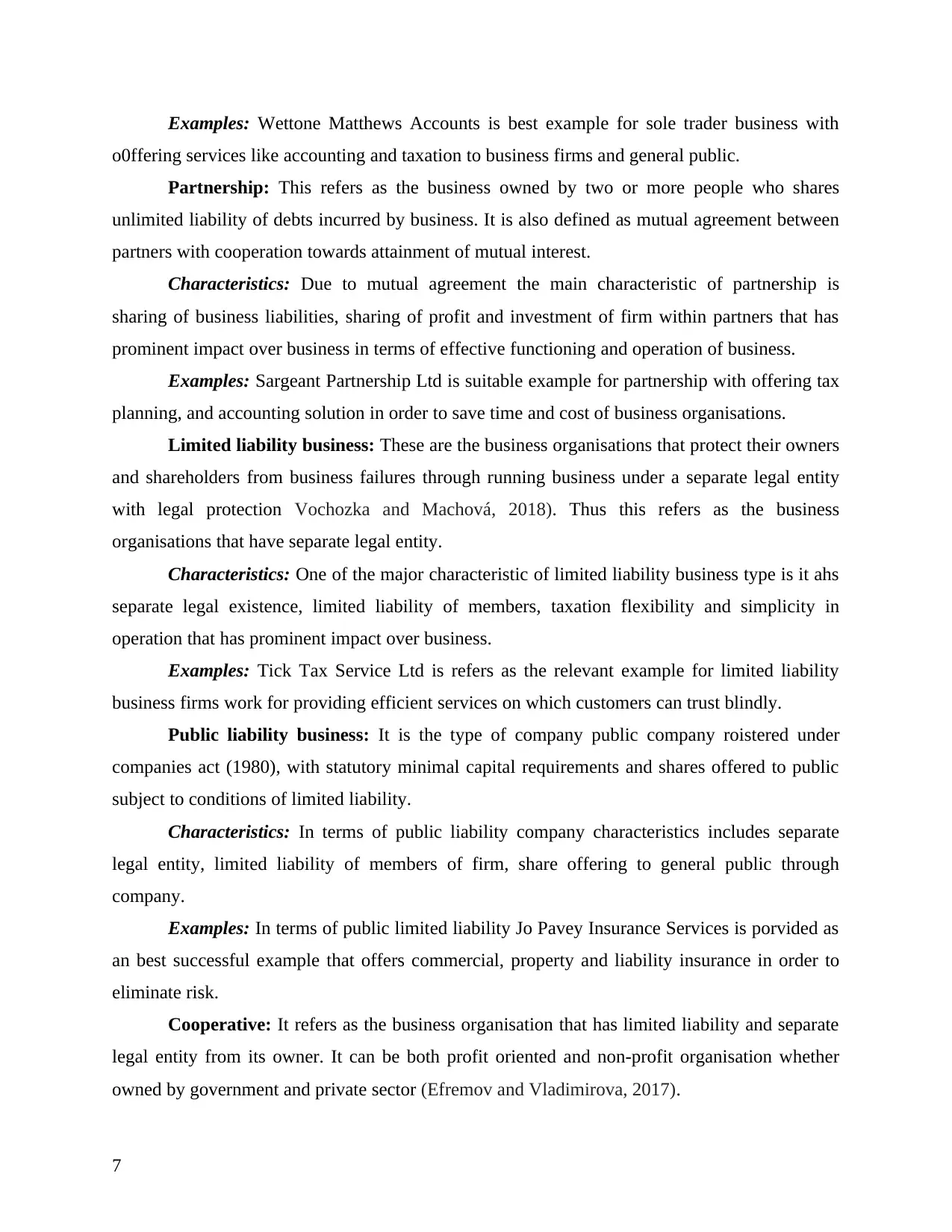
Examples: Wettone Matthews Accounts is best example for sole trader business with
o0ffering services like accounting and taxation to business firms and general public.
Partnership: This refers as the business owned by two or more people who shares
unlimited liability of debts incurred by business. It is also defined as mutual agreement between
partners with cooperation towards attainment of mutual interest.
Characteristics: Due to mutual agreement the main characteristic of partnership is
sharing of business liabilities, sharing of profit and investment of firm within partners that has
prominent impact over business in terms of effective functioning and operation of business.
Examples: Sargeant Partnership Ltd is suitable example for partnership with offering tax
planning, and accounting solution in order to save time and cost of business organisations.
Limited liability business: These are the business organisations that protect their owners
and shareholders from business failures through running business under a separate legal entity
with legal protection Vochozka and Machová, 2018). Thus this refers as the business
organisations that have separate legal entity.
Characteristics: One of the major characteristic of limited liability business type is it ahs
separate legal existence, limited liability of members, taxation flexibility and simplicity in
operation that has prominent impact over business.
Examples: Tick Tax Service Ltd is refers as the relevant example for limited liability
business firms work for providing efficient services on which customers can trust blindly.
Public liability business: It is the type of company public company roistered under
companies act (1980), with statutory minimal capital requirements and shares offered to public
subject to conditions of limited liability.
Characteristics: In terms of public liability company characteristics includes separate
legal entity, limited liability of members of firm, share offering to general public through
company.
Examples: In terms of public limited liability Jo Pavey Insurance Services is porvided as
an best successful example that offers commercial, property and liability insurance in order to
eliminate risk.
Cooperative: It refers as the business organisation that has limited liability and separate
legal entity from its owner. It can be both profit oriented and non-profit organisation whether
owned by government and private sector (Efremov and Vladimirova, 2017).
7
o0ffering services like accounting and taxation to business firms and general public.
Partnership: This refers as the business owned by two or more people who shares
unlimited liability of debts incurred by business. It is also defined as mutual agreement between
partners with cooperation towards attainment of mutual interest.
Characteristics: Due to mutual agreement the main characteristic of partnership is
sharing of business liabilities, sharing of profit and investment of firm within partners that has
prominent impact over business in terms of effective functioning and operation of business.
Examples: Sargeant Partnership Ltd is suitable example for partnership with offering tax
planning, and accounting solution in order to save time and cost of business organisations.
Limited liability business: These are the business organisations that protect their owners
and shareholders from business failures through running business under a separate legal entity
with legal protection Vochozka and Machová, 2018). Thus this refers as the business
organisations that have separate legal entity.
Characteristics: One of the major characteristic of limited liability business type is it ahs
separate legal existence, limited liability of members, taxation flexibility and simplicity in
operation that has prominent impact over business.
Examples: Tick Tax Service Ltd is refers as the relevant example for limited liability
business firms work for providing efficient services on which customers can trust blindly.
Public liability business: It is the type of company public company roistered under
companies act (1980), with statutory minimal capital requirements and shares offered to public
subject to conditions of limited liability.
Characteristics: In terms of public liability company characteristics includes separate
legal entity, limited liability of members of firm, share offering to general public through
company.
Examples: In terms of public limited liability Jo Pavey Insurance Services is porvided as
an best successful example that offers commercial, property and liability insurance in order to
eliminate risk.
Cooperative: It refers as the business organisation that has limited liability and separate
legal entity from its owner. It can be both profit oriented and non-profit organisation whether
owned by government and private sector (Efremov and Vladimirova, 2017).
7
Paraphrase This Document
Need a fresh take? Get an instant paraphrase of this document with our AI Paraphraser
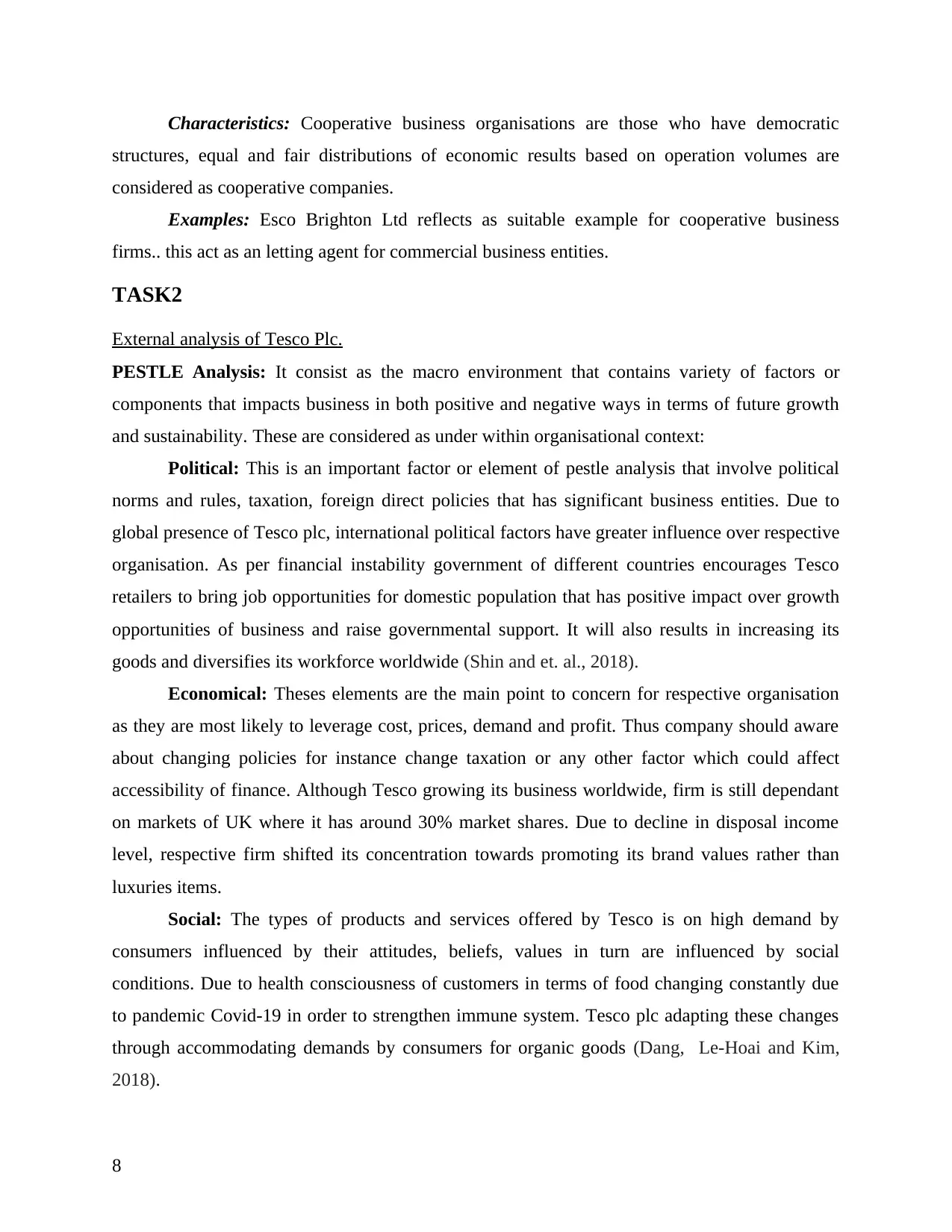
Characteristics: Cooperative business organisations are those who have democratic
structures, equal and fair distributions of economic results based on operation volumes are
considered as cooperative companies.
Examples: Esco Brighton Ltd reflects as suitable example for cooperative business
firms.. this act as an letting agent for commercial business entities.
TASK2
External analysis of Tesco Plc.
PESTLE Analysis: It consist as the macro environment that contains variety of factors or
components that impacts business in both positive and negative ways in terms of future growth
and sustainability. These are considered as under within organisational context:
Political: This is an important factor or element of pestle analysis that involve political
norms and rules, taxation, foreign direct policies that has significant business entities. Due to
global presence of Tesco plc, international political factors have greater influence over respective
organisation. As per financial instability government of different countries encourages Tesco
retailers to bring job opportunities for domestic population that has positive impact over growth
opportunities of business and raise governmental support. It will also results in increasing its
goods and diversifies its workforce worldwide (Shin and et. al., 2018).
Economical: Theses elements are the main point to concern for respective organisation
as they are most likely to leverage cost, prices, demand and profit. Thus company should aware
about changing policies for instance change taxation or any other factor which could affect
accessibility of finance. Although Tesco growing its business worldwide, firm is still dependant
on markets of UK where it has around 30% market shares. Due to decline in disposal income
level, respective firm shifted its concentration towards promoting its brand values rather than
luxuries items.
Social: The types of products and services offered by Tesco is on high demand by
consumers influenced by their attitudes, beliefs, values in turn are influenced by social
conditions. Due to health consciousness of customers in terms of food changing constantly due
to pandemic Covid-19 in order to strengthen immune system. Tesco plc adapting these changes
through accommodating demands by consumers for organic goods (Dang, Le-Hoai and Kim,
2018).
8
structures, equal and fair distributions of economic results based on operation volumes are
considered as cooperative companies.
Examples: Esco Brighton Ltd reflects as suitable example for cooperative business
firms.. this act as an letting agent for commercial business entities.
TASK2
External analysis of Tesco Plc.
PESTLE Analysis: It consist as the macro environment that contains variety of factors or
components that impacts business in both positive and negative ways in terms of future growth
and sustainability. These are considered as under within organisational context:
Political: This is an important factor or element of pestle analysis that involve political
norms and rules, taxation, foreign direct policies that has significant business entities. Due to
global presence of Tesco plc, international political factors have greater influence over respective
organisation. As per financial instability government of different countries encourages Tesco
retailers to bring job opportunities for domestic population that has positive impact over growth
opportunities of business and raise governmental support. It will also results in increasing its
goods and diversifies its workforce worldwide (Shin and et. al., 2018).
Economical: Theses elements are the main point to concern for respective organisation
as they are most likely to leverage cost, prices, demand and profit. Thus company should aware
about changing policies for instance change taxation or any other factor which could affect
accessibility of finance. Although Tesco growing its business worldwide, firm is still dependant
on markets of UK where it has around 30% market shares. Due to decline in disposal income
level, respective firm shifted its concentration towards promoting its brand values rather than
luxuries items.
Social: The types of products and services offered by Tesco is on high demand by
consumers influenced by their attitudes, beliefs, values in turn are influenced by social
conditions. Due to health consciousness of customers in terms of food changing constantly due
to pandemic Covid-19 in order to strengthen immune system. Tesco plc adapting these changes
through accommodating demands by consumers for organic goods (Dang, Le-Hoai and Kim,
2018).
8
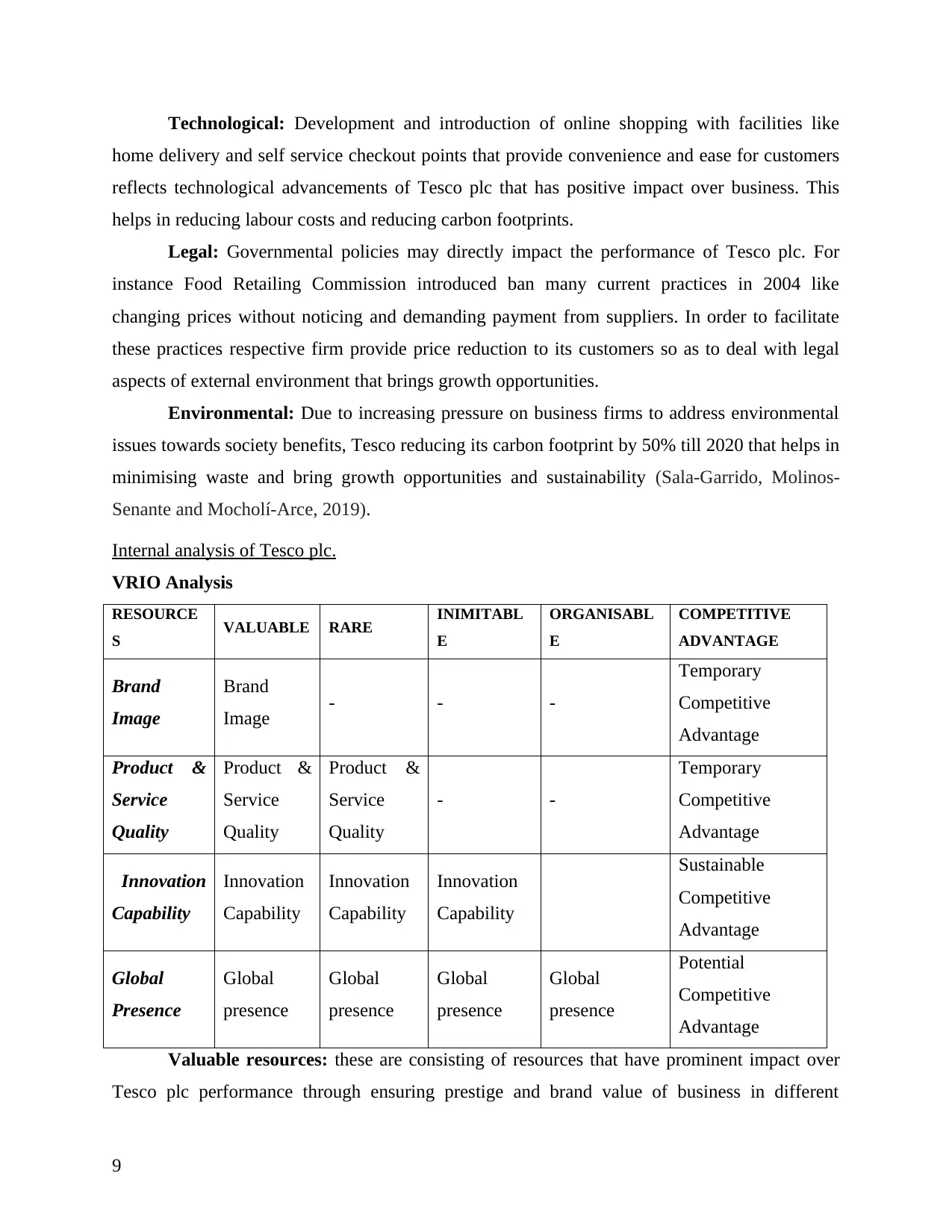
Technological: Development and introduction of online shopping with facilities like
home delivery and self service checkout points that provide convenience and ease for customers
reflects technological advancements of Tesco plc that has positive impact over business. This
helps in reducing labour costs and reducing carbon footprints.
Legal: Governmental policies may directly impact the performance of Tesco plc. For
instance Food Retailing Commission introduced ban many current practices in 2004 like
changing prices without noticing and demanding payment from suppliers. In order to facilitate
these practices respective firm provide price reduction to its customers so as to deal with legal
aspects of external environment that brings growth opportunities.
Environmental: Due to increasing pressure on business firms to address environmental
issues towards society benefits, Tesco reducing its carbon footprint by 50% till 2020 that helps in
minimising waste and bring growth opportunities and sustainability (Sala-Garrido, Molinos-
Senante and Mocholí-Arce, 2019).
Internal analysis of Tesco plc.
VRIO Analysis
RESOURCE
S VALUABLE RARE INIMITABL
E
ORGANISABL
E
COMPETITIVE
ADVANTAGE
Brand
Image
Brand
Image - - -
Temporary
Competitive
Advantage
Product &
Service
Quality
Product &
Service
Quality
Product &
Service
Quality
- -
Temporary
Competitive
Advantage
Innovation
Capability
Innovation
Capability
Innovation
Capability
Innovation
Capability
Sustainable
Competitive
Advantage
Global
Presence
Global
presence
Global
presence
Global
presence
Global
presence
Potential
Competitive
Advantage
Valuable resources: these are consisting of resources that have prominent impact over
Tesco plc performance through ensuring prestige and brand value of business in different
9
home delivery and self service checkout points that provide convenience and ease for customers
reflects technological advancements of Tesco plc that has positive impact over business. This
helps in reducing labour costs and reducing carbon footprints.
Legal: Governmental policies may directly impact the performance of Tesco plc. For
instance Food Retailing Commission introduced ban many current practices in 2004 like
changing prices without noticing and demanding payment from suppliers. In order to facilitate
these practices respective firm provide price reduction to its customers so as to deal with legal
aspects of external environment that brings growth opportunities.
Environmental: Due to increasing pressure on business firms to address environmental
issues towards society benefits, Tesco reducing its carbon footprint by 50% till 2020 that helps in
minimising waste and bring growth opportunities and sustainability (Sala-Garrido, Molinos-
Senante and Mocholí-Arce, 2019).
Internal analysis of Tesco plc.
VRIO Analysis
RESOURCE
S VALUABLE RARE INIMITABL
E
ORGANISABL
E
COMPETITIVE
ADVANTAGE
Brand
Image
Brand
Image - - -
Temporary
Competitive
Advantage
Product &
Service
Quality
Product &
Service
Quality
Product &
Service
Quality
- -
Temporary
Competitive
Advantage
Innovation
Capability
Innovation
Capability
Innovation
Capability
Innovation
Capability
Sustainable
Competitive
Advantage
Global
Presence
Global
presence
Global
presence
Global
presence
Global
presence
Potential
Competitive
Advantage
Valuable resources: these are consisting of resources that have prominent impact over
Tesco plc performance through ensuring prestige and brand value of business in different
9
⊘ This is a preview!⊘
Do you want full access?
Subscribe today to unlock all pages.

Trusted by 1+ million students worldwide
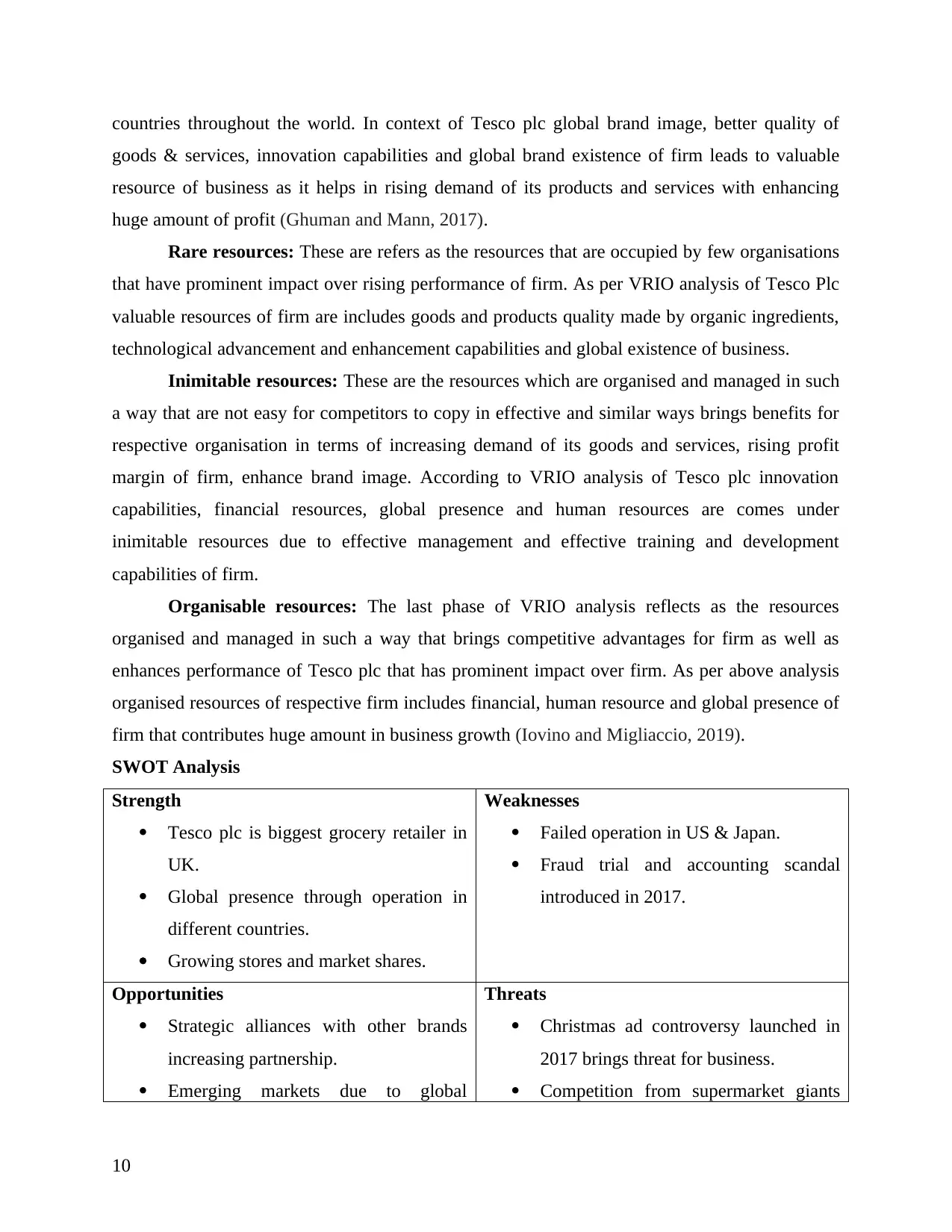
countries throughout the world. In context of Tesco plc global brand image, better quality of
goods & services, innovation capabilities and global brand existence of firm leads to valuable
resource of business as it helps in rising demand of its products and services with enhancing
huge amount of profit (Ghuman and Mann, 2017).
Rare resources: These are refers as the resources that are occupied by few organisations
that have prominent impact over rising performance of firm. As per VRIO analysis of Tesco Plc
valuable resources of firm are includes goods and products quality made by organic ingredients,
technological advancement and enhancement capabilities and global existence of business.
Inimitable resources: These are the resources which are organised and managed in such
a way that are not easy for competitors to copy in effective and similar ways brings benefits for
respective organisation in terms of increasing demand of its goods and services, rising profit
margin of firm, enhance brand image. According to VRIO analysis of Tesco plc innovation
capabilities, financial resources, global presence and human resources are comes under
inimitable resources due to effective management and effective training and development
capabilities of firm.
Organisable resources: The last phase of VRIO analysis reflects as the resources
organised and managed in such a way that brings competitive advantages for firm as well as
enhances performance of Tesco plc that has prominent impact over firm. As per above analysis
organised resources of respective firm includes financial, human resource and global presence of
firm that contributes huge amount in business growth (Iovino and Migliaccio, 2019).
SWOT Analysis
Strength
Tesco plc is biggest grocery retailer in
UK.
Global presence through operation in
different countries.
Growing stores and market shares.
Weaknesses
Failed operation in US & Japan.
Fraud trial and accounting scandal
introduced in 2017.
Opportunities
Strategic alliances with other brands
increasing partnership.
Emerging markets due to global
Threats
Christmas ad controversy launched in
2017 brings threat for business.
Competition from supermarket giants
10
goods & services, innovation capabilities and global brand existence of firm leads to valuable
resource of business as it helps in rising demand of its products and services with enhancing
huge amount of profit (Ghuman and Mann, 2017).
Rare resources: These are refers as the resources that are occupied by few organisations
that have prominent impact over rising performance of firm. As per VRIO analysis of Tesco Plc
valuable resources of firm are includes goods and products quality made by organic ingredients,
technological advancement and enhancement capabilities and global existence of business.
Inimitable resources: These are the resources which are organised and managed in such
a way that are not easy for competitors to copy in effective and similar ways brings benefits for
respective organisation in terms of increasing demand of its goods and services, rising profit
margin of firm, enhance brand image. According to VRIO analysis of Tesco plc innovation
capabilities, financial resources, global presence and human resources are comes under
inimitable resources due to effective management and effective training and development
capabilities of firm.
Organisable resources: The last phase of VRIO analysis reflects as the resources
organised and managed in such a way that brings competitive advantages for firm as well as
enhances performance of Tesco plc that has prominent impact over firm. As per above analysis
organised resources of respective firm includes financial, human resource and global presence of
firm that contributes huge amount in business growth (Iovino and Migliaccio, 2019).
SWOT Analysis
Strength
Tesco plc is biggest grocery retailer in
UK.
Global presence through operation in
different countries.
Growing stores and market shares.
Weaknesses
Failed operation in US & Japan.
Fraud trial and accounting scandal
introduced in 2017.
Opportunities
Strategic alliances with other brands
increasing partnership.
Emerging markets due to global
Threats
Christmas ad controversy launched in
2017 brings threat for business.
Competition from supermarket giants
10
Paraphrase This Document
Need a fresh take? Get an instant paraphrase of this document with our AI Paraphraser
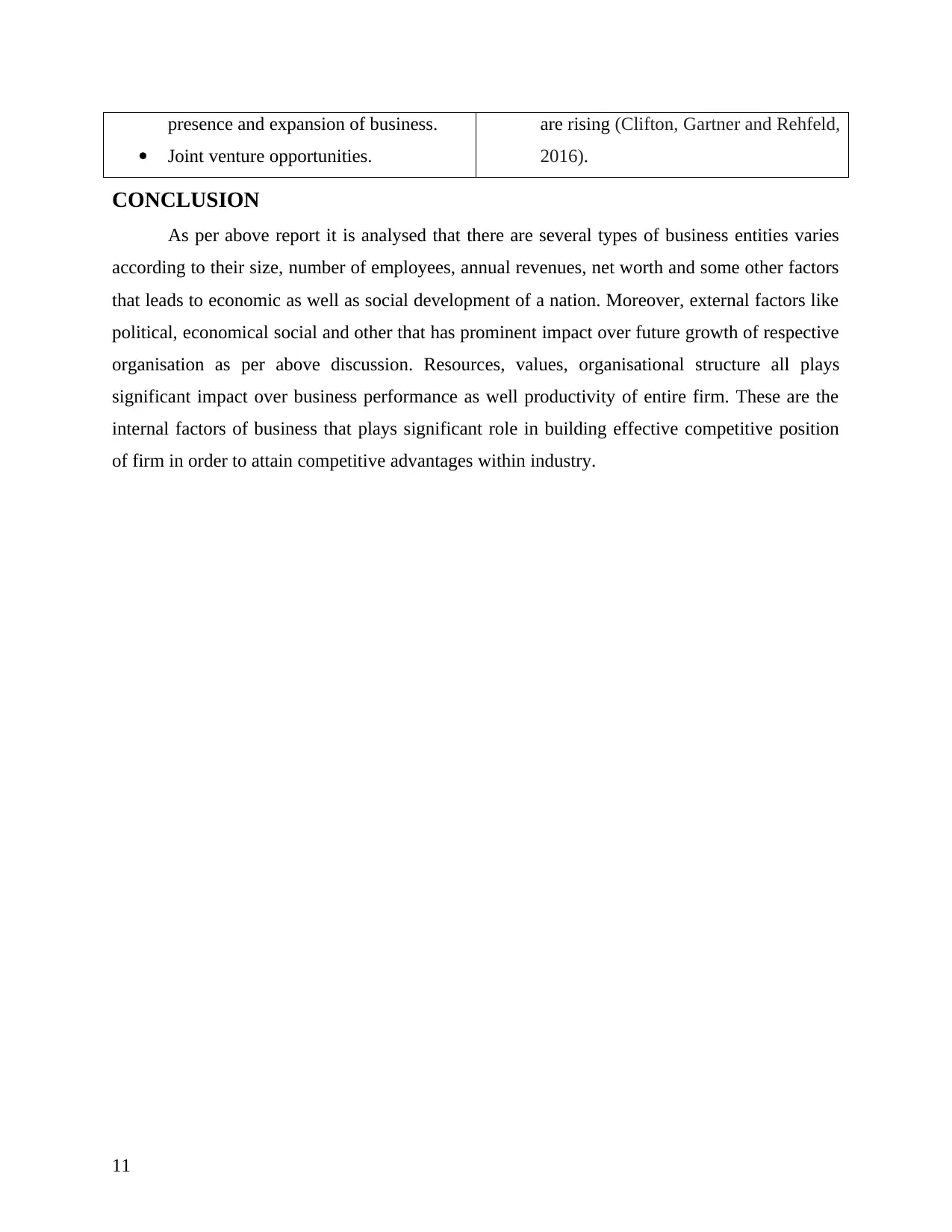
presence and expansion of business.
Joint venture opportunities.
are rising (Clifton, Gartner and Rehfeld,
2016).
CONCLUSION
As per above report it is analysed that there are several types of business entities varies
according to their size, number of employees, annual revenues, net worth and some other factors
that leads to economic as well as social development of a nation. Moreover, external factors like
political, economical social and other that has prominent impact over future growth of respective
organisation as per above discussion. Resources, values, organisational structure all plays
significant impact over business performance as well productivity of entire firm. These are the
internal factors of business that plays significant role in building effective competitive position
of firm in order to attain competitive advantages within industry.
11
Joint venture opportunities.
are rising (Clifton, Gartner and Rehfeld,
2016).
CONCLUSION
As per above report it is analysed that there are several types of business entities varies
according to their size, number of employees, annual revenues, net worth and some other factors
that leads to economic as well as social development of a nation. Moreover, external factors like
political, economical social and other that has prominent impact over future growth of respective
organisation as per above discussion. Resources, values, organisational structure all plays
significant impact over business performance as well productivity of entire firm. These are the
internal factors of business that plays significant role in building effective competitive position
of firm in order to attain competitive advantages within industry.
11
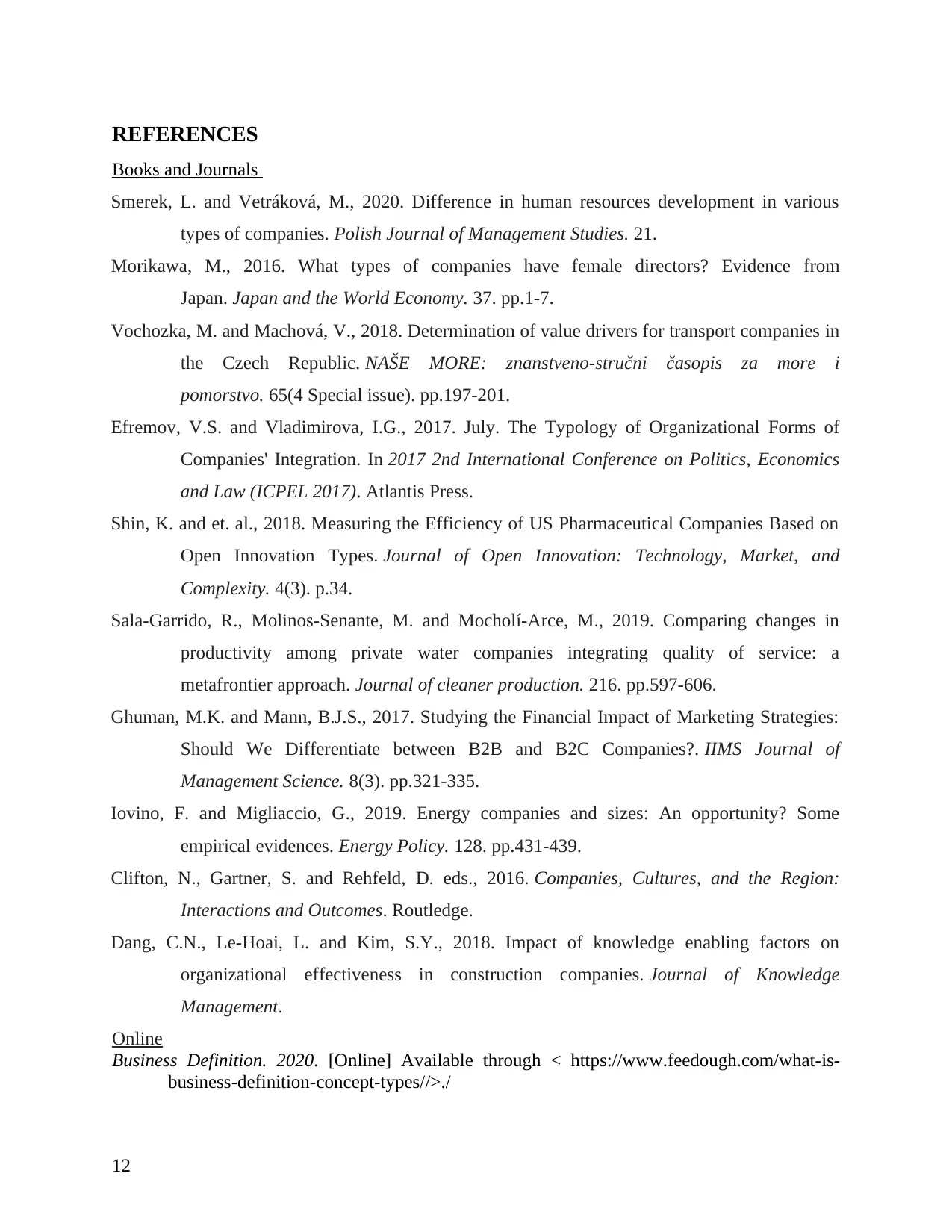
REFERENCES
Books and Journals
Smerek, L. and Vetráková, M., 2020. Difference in human resources development in various
types of companies. Polish Journal of Management Studies. 21.
Morikawa, M., 2016. What types of companies have female directors? Evidence from
Japan. Japan and the World Economy. 37. pp.1-7.
Vochozka, M. and Machová, V., 2018. Determination of value drivers for transport companies in
the Czech Republic. NAŠE MORE: znanstveno-stručni časopis za more i
pomorstvo. 65(4 Special issue). pp.197-201.
Efremov, V.S. and Vladimirova, I.G., 2017. July. The Typology of Organizational Forms of
Companies' Integration. In 2017 2nd International Conference on Politics, Economics
and Law (ICPEL 2017). Atlantis Press.
Shin, K. and et. al., 2018. Measuring the Efficiency of US Pharmaceutical Companies Based on
Open Innovation Types. Journal of Open Innovation: Technology, Market, and
Complexity. 4(3). p.34.
Sala-Garrido, R., Molinos-Senante, M. and Mocholí-Arce, M., 2019. Comparing changes in
productivity among private water companies integrating quality of service: a
metafrontier approach. Journal of cleaner production. 216. pp.597-606.
Ghuman, M.K. and Mann, B.J.S., 2017. Studying the Financial Impact of Marketing Strategies:
Should We Differentiate between B2B and B2C Companies?. IIMS Journal of
Management Science. 8(3). pp.321-335.
Iovino, F. and Migliaccio, G., 2019. Energy companies and sizes: An opportunity? Some
empirical evidences. Energy Policy. 128. pp.431-439.
Clifton, N., Gartner, S. and Rehfeld, D. eds., 2016. Companies, Cultures, and the Region:
Interactions and Outcomes. Routledge.
Dang, C.N., Le-Hoai, L. and Kim, S.Y., 2018. Impact of knowledge enabling factors on
organizational effectiveness in construction companies. Journal of Knowledge
Management.
Online
Business Definition. 2020. [Online] Available through < https://www.feedough.com/what-is-
business-definition-concept-types//>./
12
Books and Journals
Smerek, L. and Vetráková, M., 2020. Difference in human resources development in various
types of companies. Polish Journal of Management Studies. 21.
Morikawa, M., 2016. What types of companies have female directors? Evidence from
Japan. Japan and the World Economy. 37. pp.1-7.
Vochozka, M. and Machová, V., 2018. Determination of value drivers for transport companies in
the Czech Republic. NAŠE MORE: znanstveno-stručni časopis za more i
pomorstvo. 65(4 Special issue). pp.197-201.
Efremov, V.S. and Vladimirova, I.G., 2017. July. The Typology of Organizational Forms of
Companies' Integration. In 2017 2nd International Conference on Politics, Economics
and Law (ICPEL 2017). Atlantis Press.
Shin, K. and et. al., 2018. Measuring the Efficiency of US Pharmaceutical Companies Based on
Open Innovation Types. Journal of Open Innovation: Technology, Market, and
Complexity. 4(3). p.34.
Sala-Garrido, R., Molinos-Senante, M. and Mocholí-Arce, M., 2019. Comparing changes in
productivity among private water companies integrating quality of service: a
metafrontier approach. Journal of cleaner production. 216. pp.597-606.
Ghuman, M.K. and Mann, B.J.S., 2017. Studying the Financial Impact of Marketing Strategies:
Should We Differentiate between B2B and B2C Companies?. IIMS Journal of
Management Science. 8(3). pp.321-335.
Iovino, F. and Migliaccio, G., 2019. Energy companies and sizes: An opportunity? Some
empirical evidences. Energy Policy. 128. pp.431-439.
Clifton, N., Gartner, S. and Rehfeld, D. eds., 2016. Companies, Cultures, and the Region:
Interactions and Outcomes. Routledge.
Dang, C.N., Le-Hoai, L. and Kim, S.Y., 2018. Impact of knowledge enabling factors on
organizational effectiveness in construction companies. Journal of Knowledge
Management.
Online
Business Definition. 2020. [Online] Available through < https://www.feedough.com/what-is-
business-definition-concept-types//>./
12
⊘ This is a preview!⊘
Do you want full access?
Subscribe today to unlock all pages.

Trusted by 1+ million students worldwide
1 out of 13
Related Documents
Your All-in-One AI-Powered Toolkit for Academic Success.
+13062052269
info@desklib.com
Available 24*7 on WhatsApp / Email
![[object Object]](/_next/static/media/star-bottom.7253800d.svg)
Unlock your academic potential
Copyright © 2020–2025 A2Z Services. All Rights Reserved. Developed and managed by ZUCOL.





